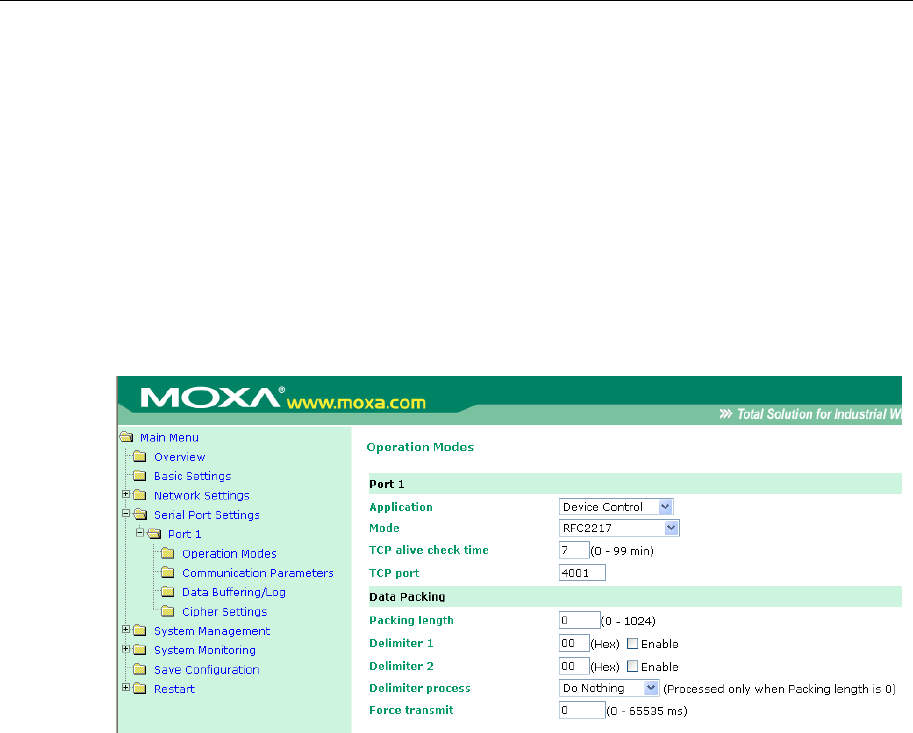User`s manual
Table Of Contents
- 1. Introduction
- 2. Getting Started
- 3. Initial IP Address Configuration
- 4. Introducing Serial Port Operation Modes
- 5. Introducing OnCell Central and Ethernet Operation Modes
- 6. Using the Web Console
- 7. Cellular Network Settings
- 8. Configuring Serial Port Operation Modes
- 9. Configuring the Cellular-Enabling Ethernet Device
- 10. Configuring OnCell Central Management Software
- 11. Additional Serial Port Settings
- 12. System Management Settings
- 13. Software Installation/Configuration
- A. Pinouts and Cable Wiring
- B. RFC2217
- C. Dynamic Domain Name Server
- D. Well Known Port Numbers
- E. Auto IP Report Protocol
- F. GSM Alphabet
- G. Default Settings

OnCell G3111/G3151/G3211/G3251 Series User’s Manual Serial Port Operation Modes
8-8
The optimal force transmit time depends on your application, but it must be at least larger than one
character interval within the specified baudrate. For example, assume that the serial port is set to
1200 bps, 8 data bits, 1 stop bit, and no parity. In this case, the total number of bits needed to send
a character is 10 bits, and the time required to transfer one character is
(10 (bits) / 1200 (bits/s)) × 1000 (ms/s) = 8.3 ms.
Therefore, you should set the force transmit time to be greater than 8.3 ms, so in this case, it must
be greater than or equal to 10 ms.
If it is necessary to send a series of characters in the same packet, the serial device will need to
send that series of characters within the specified force transmit time, and the total length of data
must be less than or equal to the OnCell G3111/G3151/G3211/G3251’s internal buffer size (1 KB
per port).
RFC2217 Mode
TCP alive check time (default=7 min): This field specifies how long the OnCell
G3111/G3151/G3211/G3251 will wait for a response to “keep alive” packets before closing the TCP
connection. The OnCell G3111/G3151/G3211/G3251 checks connection status by sending periodic
“keep alive” packets. If the remote host does not respond to the packet within the time specified in
this field, the OnCell G3111/G3151/G3211/G3251 will force the existing TCP connection to close.
For socket and device control modes, the OnCell G3111/G3151/G3211/G3251 will listen for
another TCP connection from another host after closing the connection. If TCP alive check time is
set to 0, the TCP connection will remain open even if there is no response to the “keep alive”
packets.
TCP port (default=4001): This is the TCP port number assignment for the serial port on the OnCell
G3111/G3151/G3211/G3251. It is the port number that the serial port uses to listen to connections,
and that other devices must use to contact the serial port. To avoid conflicts with well known TCP
ports, the default is set to 4001.
Packet length (default=0): The Packet length setting refers to the maximum amount of data that is
allowed to accumulate in the serial port buffer before sending. At the default of 0 for packet length,
no maximum amount is specified and data in the buffer will be sent as specified by the delimiter
settings or when the buffer is full. When a packet length between 1 and 1024 bytes is specified, data
in the buffer will be sent as soon it reaches the specified length.
Delimiter 1 and Delimiter 2 (default=None): When Delimiter 1 is enabled, the serial port will clear
the buffer and send the data to the Ethernet port when a specific character, entered in hex format, is
received. A second delimiter character may be enabled and specified in the Delimiter 2 field, so that










